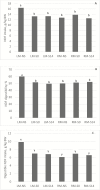Voluntary intake and digestibility by sheep of alfalfa ensiled at different moisture concentrations following fertilization with dairy slurry
- PMID: 29401268
- PMCID: PMC6093516
- DOI: 10.1093/jas/skx061
Voluntary intake and digestibility by sheep of alfalfa ensiled at different moisture concentrations following fertilization with dairy slurry
Abstract
Dairy slurry is used commonly as an animal-sourced fertilizer in agronomic production. However, residual effects of slurry application on intake and digestibility of alfalfa (Medicago sativa L.) silage from subsequent harvests are not well known. The objective of this study was to determine if moisture concentration of alfalfa silage and timing of dairy slurry application relative to subsequent harvest affected intake and digestibility by sheep. Katahdin crossbred ewes (n = 18; 48 ± 5.3 kg) in mid-gestation were stratified by BW and allocated randomly in each of two periods to one of six treatments arranged in a two × three factorial arrangement. Treatments consisted of recommended (RM; 46.8%) or low (LM; 39.7%) moisture at baling after either no slurry application (NS), slurry application to stubble immediately after removal of the previous cutting (S0), or slurry application 14 d after removal of the previous cutting (S14). Silages were chopped through a commercial straw chopper, packed into plastic trash cans, and then offered to ewes within 4 d of chopping. Period 1 of the intake and digestion study consisted of a 14-d adaptation followed by a 7-d fecal collection period. Period 2 followed period 1 after a 4-d rest and consisted of an 11-d adaptation followed by 7 d of fecal collection. Ewes were housed individually in 1.4 × 4.3-m pens equipped with rubber mat flooring. Feces were swept from the floor twice daily, weighed, and dried at 50 °C. Ewes had ad libitum access to water and were offered chopped silage for a minimum of 10% refusal (DM). Blood samples were collected immediately prior to feeding, and 4 and 8 h after feeding on the day prior to the end of each period. Organic matter intake (g/kg BW) and OM digestibility tended (P < 0.10) to be, and digestible OM intake (g/kg BW) was reduced by slurry application. Lymphocytes (% of total white blood cells) were greater (P < 0.05) from LM vs. RM and from NS vs. S0 and S14. Red blood cell concentrations were greater (P < 0.05) from S14 vs. S0 and from S0 and S14 vs. NS. Serum urea N concentrations did not differ (P > 0.17) across treatments. Therefore, moisture concentration of alfalfa silage within the range used in this study may not affect voluntary intake or digestibility, but slurry application may have an effect on digestible OM intake. Also, moisture concentration of alfalfa silage and time of dairy slurry application may affect specific blood hemograms.
Figures

References
-
- AOAC 2000. Official methods of analysis. 17th ed. Gaithersburg, MD: Association of Official Analytical Chemists International.
-
- Coblentz W. K., Muck R. E., Borchardt M. A., Spencer S. K., Jokela W. E., Bertram M. G., and Coffey K. P.. 2014. Effects of dairy slurry on silage fermentation characteristics and nutritive value of alfalfa. J. Dairy Sci. 97:7197–7211. doi:10.3168/jds.2014-8582 - PubMed
-
- Crotty F. V., Fychan R., Theobald V. J., Sanderson R., Chadwick D. R., and Marley C. L.. 2014. The impact of using alternative forages on the nutrient value within slurry and its implications for forage productivity in agricultural systems. PLoS One 9:e97516. doi:10.1371/journal.pone.0097516 - PMC - PubMed
-
- Etheridge M. O., Stockdale C. R., and Cranwell P. D.. 1993. Influence of method of conservation of Lucerne on factors associated with voluntary intake in sheep. Aust. J. Exp. Agric. 33:417–423. doi:10.1071/EA9930417
MeSH terms
Substances
LinkOut - more resources
Full Text Sources
Other Literature Sources
Miscellaneous

